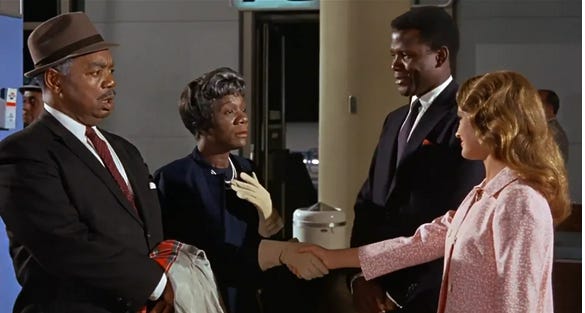“Tell me something. It ever occur to you that this might happen?” That’s the question Matt (Spencer Tracy) has for his wife Christina (Katharine Hepburn). The “this” is familial miscegenation: their daughter Joey (Katharine Houghton) has gotten engaged to a Black man.
Now, because this is one of ol’ Stanley Kramer’s “message films,” he’s gonna make his stance on the film’s central issue black and white glaringly obvious. To wit, Joey’s fiancé is Dr. John Wade Prentice (Sidney Poitier), a Black man engineered in a lab to be acceptable to white people. This allows Kramer easy commentary on the hypocritical rictus of San Francisco’s performative liberals when change comes a-knocking.1
The film revolves around Dr. John’s declaration to Joey’s parents that they must consent to the marriage or he’ll call it off. He also insists that they make that decision tonight.2 Meanwhile, Joey has invited John’s parents to dinner, and when she picks them up at the airport, that’s when they discover that their son is engaged to a white woman.
Anyway, you can watch Spencer Tracy’s big speech at the end: he recaps the full movie, straight-up tells you the theme3, and finally gives his blessing to those two crazy kids.
Rating: 6/10. Love’s love, man.
Cast and Crew
We’ve watched five other Spencer Tracy films4 so far for this column, but this is the first one featuring both him and Katharine Hepburn. That pair starred together in nine films and ohbytheway also had a 26-year affair.5
In Tracy’s youth, he was one of Hollywood’s most notorious alcoholics, and by the 1960s his health had faltered. He kept up his collaborations with Stanley Kramer6 but made few other movies. His health was so poor before the filming of Guess Who’s Coming to Dinner? that he couldn’t be insured—Hepburn had to put up her salary to back him. Tracy made it through filming but died seventeen days later; his nomination for the Oscar was posthumous. He lost while Hepburn won, and when she found this out, she said “well, I’m sure mine is for the two of us.”
We’ll see Kat Hepburn twice more, including in a film from 1968.
So Sidney Poitier. This dude’s 1967: In the Heat of the Night, Guess Who’s Coming to Dinner?, and To Sir, with Love7 (probably the best movie of the three). Zero Oscar nominations. What’s a guy gotta do?
In the Heat of the Night and Guess Who’s Coming to Dinner? make up a nice one-two punch of films where Sidney Poitier’s characters face racism. You can slide The Defiant Ones and A Patch of Blue (1965)8 into that category too. I’m glad we watched Lilies of the Field, a film where Poitier got to get into some misadventures not related to the color of his skin.
So that’s six movies to keep in mind. If you remember that Poitier was Bahamian, that he was the first Black man to win a competitive Oscar, and that he originated the role of Walter Lee Younger on Broadway in “A Raisin in the Sun,” then you should be gettin’ most of your Poitier questions right.9 But also try to remember that Poitier was more than just the sum of his parts—he was a trailblazer, a symbol of dignity and strength, a breaker of barriers.
Quick Hits:
Isabel Sanford played Tillie, the housekeeper who drops the film’s only n-bomb on Dr. John Prentice. Sanford was later Louise “Weezy” Jefferson on “All in the Family” and “The Jeffersons,” a role for which she was nominated for seven (!) Emmys.
Beah Richards, playing Dr. John’s mother, got to give the best speech in the film and received an Oscar nomination for her work.
Cecil Kellaway also scored an Oscar nod for his role as Monsignor Mike Ryan. Yeah, basically everyone associated with this film was nominated except Sidney Poitier.
The Trivia
In the film, Joey mentions the female governor of Alabama. That woman was Lurleen Wallace, the third female governor in U.S. history and the first wife of former Alabama governor George Wallace. Let’s talk a bit about lady governors.10
The first female state governor was Nellie Tayloe Ross, who was governor of the Equality State, Wyoming. She was elected on the same day in 1924 as Texas’ Miriam “Ma” Ferguson, but Ross took office first.11 Ross, Ferguson, and Lurleen Wallace all had husbands who had previously been governor:
Ross’ governor husband had died; she won the special election for his seat.
Both Ferguson and Wallace ran so their former governor hubbies could remain de facto governor. Hubby Ferguson had been impeached and banned from holding office while hubby Wallace couldn’t be governor because Alabama’s constitution forbade consecutive terms.
The first female governor whose husband hadn’t been governor was the next one, Ella Grasso of Connecticut (governor 1975–1980). To date, 32 states have had female governors. Arizona has had the most, with 5; next are New Hampshire (4) and Kansas and Oregon (3 each).
But if we’re talking about Lurleen Wallace, that means we should talk about her husband, Mister “segregation now, segregation tomorrow, segregation forever” himself, George Wallace. He became nationally famous in 1963 when he tried to prevent Vivian Malone and James Hood, two students of color, from registering at the University of Alabama by standing in the “schoolhouse door” (the doorway to Foster Auditorium).
Wallace used his newfound fame to launch runs for the Democratic nomination for president four times (1964, 1968, 1972, and 1976). He never won the nomination, but in 1968 he ran as a third party candidate under the “American Independent” label, won 13.5% of the vote, and carried five states in the deep South (the last time a third party candidate has won a state).
The end of Wallace’s story is interesting. While running for president in 1972, he was shot by would-be assassin Arthur Bremer.12 The attack left Wallace paralyzed from the waist down. By the late 1970s, Wallace realized he had been on the wrong side of history and apologized for all the “segregation forever” stuff. He said “I was wrong. Those days are over, and they ought to be over.” Vivian Malone and James Hood both met with and forgave Wallace at the end of his life.13
We’ll see George Wallace and Vivian Malone again in, uh, Forrest Gump (1994).
Speed Round: Third Party Candidates
We mentioned that George Wallace was the last third party candidate who won a state. Here are the other 20th century gents who achieved that feat:
Theodore Roosevelt as part of the Progressive (“Bull Moose”) Party in 1912. He carried six states, while incumbent president Taft (from whose Republican party Teddy split) only carried two. The break led to Democrat Woodrow Wilson being elected despite only garnering 42% of the vote.
Robert M. “Fightin’ Bob” La Follette, taking up the mantle of the Progressive Party in 1924. He only won his home state of Wisconsin.
Strom Thurmond, who split off from the Dems to form the States’ Rights Democratic party (also called the Dixiecrats) in 1948. He won four states in the deep South (three of which would be carried by Wallace twenty years later).
And how about some also-rans who got some people to vote for them?
1912 wasn’t just about Teddy Roosevelt: it also had five-time Socialist candidate Eugene V. Debs’ best showing in votes (as a percentage of the total).
1980: John Anderson as an Independent running a “campaign of ideas” and attacking Reagan from the center.
1992 and 1996: Ross Perot, first as an Independent and then as the standard-bearer of the Reform party. (Also, I can’t recommend this three-part series from Pretty Good on the Reform party highly enough.)
Odds and Ends
Dr. Prentice discusses the Watusi dance with Matt; it’s named for the Rwandan Tutsis but is an American dance named for the Orlons song “The Wah-Watusi”14…Katharine Houghton was Katharine Hepburn’s niece…in the play (and later film) “Six Degrees of Separation,” a con man pretends to be the son of Sidney Poitier…1967’s Supreme Court case Loving v. Virginia ruled that state laws banning interracial marriage were unconstitutional—though didn’t Sayonara already teach us that interracial marriage is a non-issue?
One last thing: Guess Who’s Coming to Dinner? had a race-swapped remake, the 2005 Bernie Mac vehicle Guess Who. In it, a white guy (played by 2005’s whitest guy, Ashton Kutcher) meets his Black girlfriend’s parents. It made one hundred million dollars.
Compare this to last week’s In the Heat of the Night, where the racism was the deep South’s use of hard-r slurs and lynching. It probably didn’t rise to the level of “commentary,” though—instead, the film used racism for atmosphere, creating a feeling of menace.
Why yes, this is artificial urgency concocted by the filmmakers to make the plot seem more dramatic, why do you ask.
Spoiler: he decides racism’s bad.
Apparently Tracy once said “I can get a divorce whenever I want to, but my wife and Kate like things just as they are.” Also, perhaps Kat and Spence’s relationship was a cover for the homosexuality of one—or both?—of them.
We’ve now seen three of them, missing only 1963’s It’s A Mad, Mad, Mad, Mad World.
To Sir, with Love is based on an E.R. Braithwaite novel about an immigrant teaching at a tough England school. It was directed by James Clavell (who wrote “Shogun”) and co-starred Lulu, who also did the theme song “To Sir with Love” (no comma) that reached #1.
A blind girl, played by Elizabeth Hartman, falls in love with Poitier’s character, not knowing he’s Black. Then her mom (Shelley Winters) goes crazy.
I mean, if you wanted to overachieve, you could keep the films Blackboard Jungle (1955) and Porgy and Bess (1959) in the back of your mind too.
Note: “governess” doesn’t mean “lady governor.”
Though Ferguson’s election was a general election while Ross’ was a special election.
Arthur Bremer was imprisoned for 35 years, then released in 2007. He’s still alive. Another guy who tried to kill a guy who’s still alive and free? John Hinckley Jr. In fact, Hinckley’s making music on YouTube.
Hood spent hours with Wallace working on a book about him and even attended Wallace’s funeral. Not for nothing, this would make a movie at least as good as Green Book (2018).







